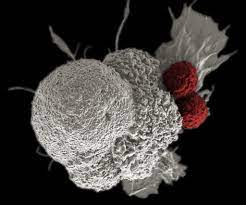Each cell contains a saving code, having the ability to cause the self-destruction of cells that become cancerous, reveals this study from Northwestern Medicine (Chicago). As soon as this "bodyguard" senses that the cell is mutating to become cancerous, he introduces a destruction code to eliminate it. This natural process of cancer elimination, first documented in the journal Nature Communications, appears to be a promising basis for new therapies.
This new neutralization code integrated into each cell, triggered by chemotherapy, could be triggered without chemotherapy, thus avoiding side effects. The idea of the Chicago scientists is to take advantage of "this mechanism that nature has developed", especially since according to research, cancer cannot become resistant to this mechanism. In previous research published in 2017, the team had already shown that cancer cells die after the introduction of small RNA molecules and that these treated cancer cells never become resistant, because they simultaneously eliminate the genes necessary "for cancer ".
The code in question is embedded in large protein-coding ribonucleic acids (RNAs) and small RNAs, called microRNAs, which are thought to have evolved more than 800 million years ago to protect the body against cancer. These toxic small RNA molecules are also triggered by chemotherapy, the authors report. In addition, cancer cannot adapt or become resistant to these toxic RNAs, which makes it a promising treatment, assuming that this code that is both destructive (against cancer cells) and life-saving can be duplicated synthetically. .
A sequence of 6 nucleotides (organic molecules that make up DNA and RNA) present in small RNAs makes them toxic to cancer cells. Here, researchers worked to identify the most toxic combination and discovered which microRNAs expressed in the body were most effective at fighting cancer. They show that the cells cut a small gene (Fas ligand) involved in the growth of cancerous cells into small pieces which then act as toxic microRNAs for cancer.
The lack of resistance of cancer cells to these "new" molecules: this advantage is described as a "first" by scientists who seek to trigger the mechanism without resorting to chemotherapy and/or genome editing. "The idea here is to use these small RNAs directly, introduce them into cells, and trigger the self-destruct switch," says lead author Dr. Marcus E Peter, professor of cancer metabolism at the FeinbergSchool of Medicine.
The absence of undesirable effects linked to chemotherapy would be a second advantage , all the more important as some of its side effects can cause secondary cancers.
It would therefore be theoretically possible to design artificial microRNAs capable of killing cancer cells and even more powerful than those developed by nature. The goal is to develop a new form of therapy that involves triggering this built-in destruction code to kill cancer cells.
